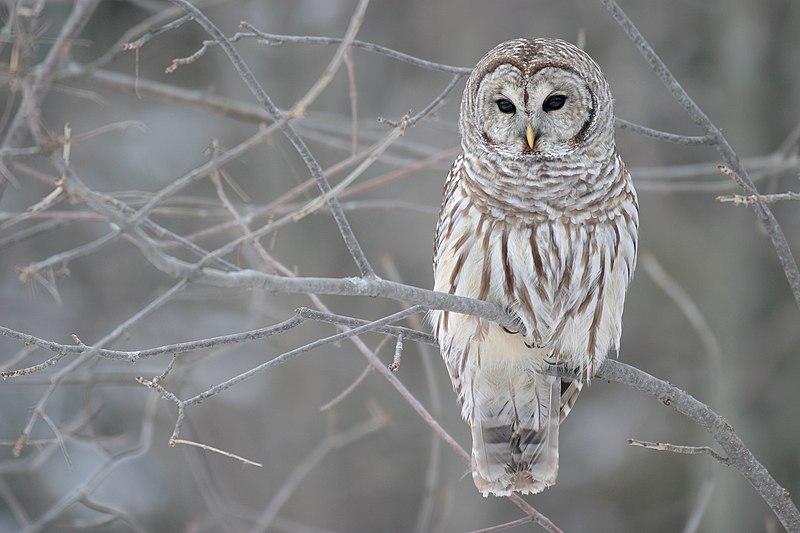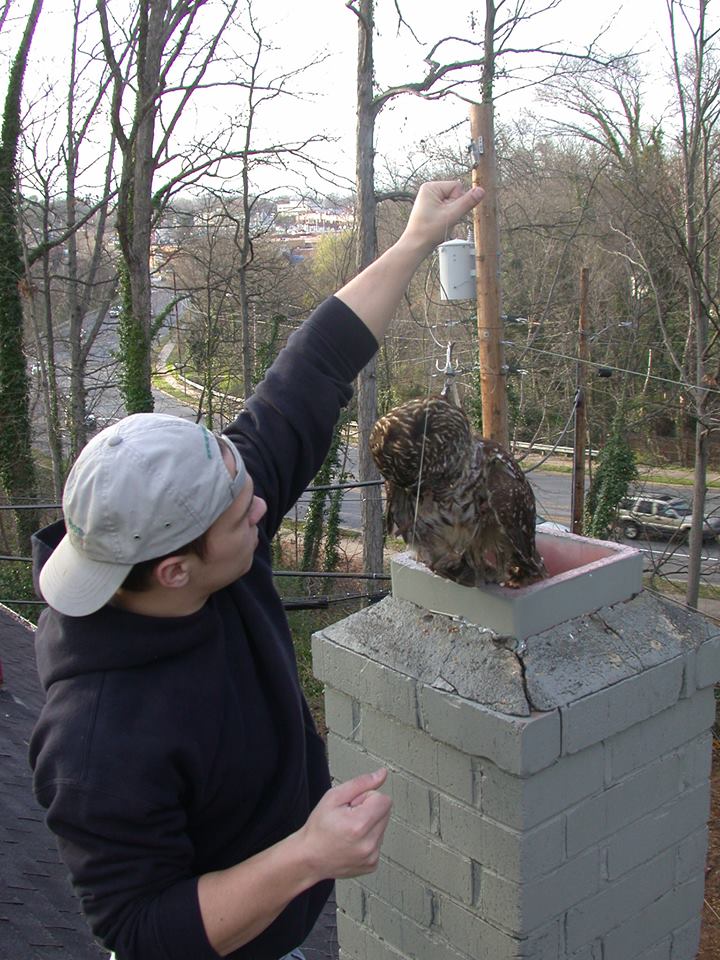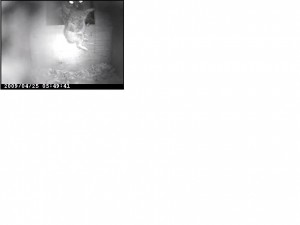Overview of the Study
So what’s the story behind Charlotte’s Barred Owls? Well, it’s quite a hoot I must say! Originally, it was thought that Barred Owls needed large areas of old-growth forest to survive, but it turns out they’re doing just fine adapting to their urban habitats. So how have they adapted? It seems that city birds eat larger meals less often than owls that live in the countryside. They also find many a nesting site throughout welcoming neighborhoods. For the complete research synopsis read Rob Bierregaards Barred Owl page.
So how were these conclusions drawn? How does one study Barred Owls?
Barred Owl Sighting
Have you ever seen an owl? The first time you spot one it’s an exhilarating experience, especially if you see one during the day. One of the most remarkable aspects of seeing a Barred Owl for the first time is the lack of sound. If you catch one in flight you can’t hear anything. Owls have comb-like projections on the tips of their primary feathers to break down turbulence and eliminate sound. Pretty cool, huh?
However, if you do hear calling it can help you locate them. In the south they’re called hoot owls for a reason. They consecutively hoot: “Hoot hoot hoot hoot, hoot hoot hoot hoot hoo!” Click to hear Barred Owl call. Once found you’ll notice their distinguishing and remarkable plumage:
To Catch a Barred Owl
So how does one catch a Barred Owl? This is one of the questions I get in relation to this study most often. Barred owls are opportunistic primarily nocturnal predators. The word opportunistic is emphasized here. Often times people spot owls during the day and are surprised. They eat whenever the opportunity arises. In the field we take advantage of this behavior with traps. There are many bird traps but two (both harmless) are primarily used to trap Barred Owls. The first is called a bal-chatri (pronounced ball-sha-tree) and the second a dho gazza (pronounced doo gazza)
Besides having awesome names, the traps have been invaluable for catching birds of prey for hundreds of years. They have widely been used for the practice of Falconry. Deriving from India, a bal-chatri consists of a cage covered in miniature nooses (we’ll call them mooses) made of rope or filament. The cage is of variable size and shape as is the material of its construction. Our cages were rectangular and made of wire mesh. Our mooses were made of nylon filament. Many mooses are tied on top of the cage. A small rodent or bird is then inserted into the cage. These days, mechanical prey are often used instead of live animals. When a bird of prey swoops down to capture their prey they become tangled in the mooses:

Another trap often used to catch birds of prey is a dho gazza. A dho gazza is a net suspended between two poles by removable clips. Prey is then placed on a platform above the ground close to the net. When the bird of prey swoops down to capture their prey, unable to fly up at such an angle, they fly into the net which then surrounds them.
After Capture
After we capture the owls many important characteristics are noted such as weight and length measurements as well as overall heath, molting stages, breeding condition, etc. depending on the season. Many owls are also adorned with radio transmitters that allow us to track their behaviors.
Radio Telemetry
Our radio transmitters emit a small “beep” when in close proximity of the owls. Once tagged, we would return often to the site of capture. Using a receiver and antenna late at night we follow the signal. An increase in the frequency of “beeps” signifies a closer distance to the tagged owl. This process starts in a vehicle and then proceeds on foot. Once found, their location is noted. These locations are then charted into Google Earth in an effort to map the territory of each owl. In Charlotte, it seems there are about 2 pairs of owls per square mile so real estate is going rather quickly these days. The owl is then usually followed and monitored for behavior (feeding, roosting, meeting with mates, etc) for as long as we can keep up!
Other methods of monitoring
Nests are also monitored during the breeding season for prey delivery as well as the behavior of young fledglings. Barred owls usually nest in large holes in trees. However, they’ll also nest in boxes. So, we build and maintain a number of boxes in Charlotte. Most of them were used for nesting and some of them had permanent cameras. All of them are checked at the beginning and throughout the breeding season. We also monitor feeding habits and prey deliveries with these cameras. Click here to see one of our owls eating a rabbit!



